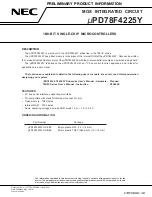
10-15
[ 7 ]
Heat sink overheat
Problem Temperature around heat sink has risen abnormally.
Possible Causes
What to Check and Suggested Measures
(1) Temperature around the
inverter exceeded the
inverter's specification
range.
Measure the temperature around the inverter.
Lower the temperature around the inverter (e.g., ventilate the panel where the
inverter is mounted).
(2) Ventilation path is blocked.
Check if there is sufficient clearance around the inverter.
Change the mounting place to ensure the clearance.
Check if the heat sink is not clogged.
Clean the heat sink.
(3) Cooling fan's airflow volume
decreased due to the
service life expired or failure.
Check the cumulative run time of the cooling fan. Refer to Chapter 3, Section
3.4.6 "Reading maintenance information – Menu #5 "Maintenance Information"."
Replace the cooling fan.
Visually check whether the cooling fan rotates normally.
Replace the cooling fan.
Inverters of 60 HP or above for three-phase 230 V series and those of 125 HP or
above for three-phase 460 V series are equipped with not only a cooling fan for
heat sink but also an internal air circulation fan. Check the following.
Check the connection of the fan power switching connectors "CN R" and
"CN W."
Correct the connection. (Refer to "
Switching connectors" in Chapter 2,
Section 2.3.4 "Wiring of main circuit terminals and grounding terminals".
(4) Overload.
Measure the output current.
Reduce the load (e.g. Use the heat sink overheat early warning (E01 through
E07) or the overload early warning (E34) and reduce the load before the
overload protection is activated.).
Decrease the motor sound (carrier frequency) (F26).
Enable the overload prevention control (H70).
(5) Running on single-phase
power
Refer to Section 10.7 "If the Inverter is Running on Single-Phase Power, [ 1 ]
and [ 6 ].
[ 8 ]
External alarm
Problem External alarm was inputted (
THR
).
(when the "Enable external alarm trip"
THR
has been assigned to any of digital input terminals)
Possible Causes
What to Check and Suggested Measures
(1) An alarm function of external
equipment was activated.
Check the operation of external equipment.
Remove the cause of the alarm that occurred.
(2) Wrong connection or poor
contact in external alarm
signal wiring.
Check if the external alarm signal wiring is correctly connected to the terminal to
which the "Enable external alarm trip" terminal command
THR
has been
assigned (Any of E01 through E07, E98, and E99 should be set to "9.").
Connect the external alarm signal wire correctly.
(3) Incorrect setting of function
code data.
Check whether the "Enable external alarm trip" terminal command
THR
has
been assigned to an unavailable terminal (with E01 through E07, E98, or E99).
Correct the assignment.
Check whether the normal/negative logic of the external signal matches that of
the
THR
command specified by any of E01 through E07, E98, and E99.
Ensure the matching of the normal/negative logic.
[ 9 ]
Inverter internal overheat
Problem Temperature inside the inverter has exceeded the allowable limit.
Possible Causes
What to Check and Suggested Measures
(1) The surrounding
temperature exceeded the
inverter's specification limit.
Measure the surrounding temperature.
Lower the temperature around the inverter (e.g., ventilate the panel where
the inverter is mounted).
(2) Running on single-phase
power
Refer to Section 10.7 "If the Inverter is Running on Single-Phase Power," [ 6 ].
Содержание EQ7 Series
Страница 1: ......
Страница 29: ...2 6 Unit inch mm Refer to Section 2 3 3 9 ...
Страница 94: ...4 25 Table B Motor Parameters Continued Three phase 460 V series EQ7 4_ _ _ C ...
Страница 152: ...4 83 Examples of Sequence Circuits 1 Standard sequence 2 Sequence with an emergency switching function ...
















































